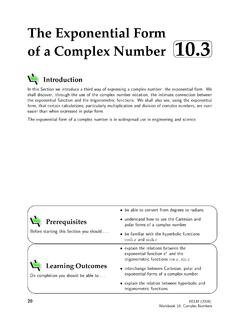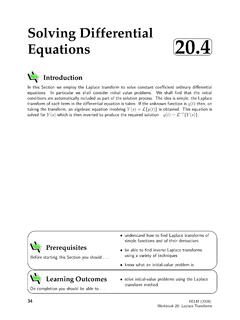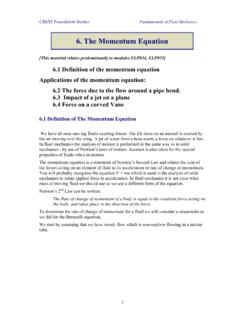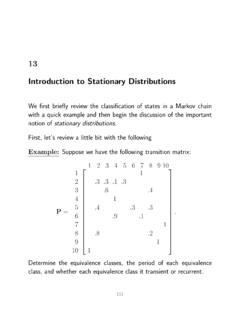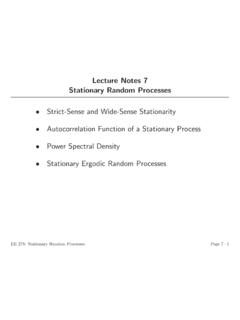Transcription of Stationary Points 18 - Loughborough University
1 Stationary Points calculation of the optimum value of a function of two variables is a common requirement in manyareas of engineering, for example in thermodynamics. Unlike the case of a function of one variablewe have to use more complicated criteria to distinguish between the various types of Stationary point. PrerequisitesBefore starting this Section you understand the idea of a function of twovariables be able to work out partial derivatives'&$%Learning OutcomesOn completion you should be able identify local maximum Points , localminimum Points and saddle Points on thesurfacez=f(x,y) use first partial derivatives to locate thestationary Points of a functionf(x,y) use second partial derivatives to determinethe nature of a Stationary pointHELM (2008):Section : Stationary Points211. The Stationary Points of a function of two variablesFigure 7 shows a computer generated picture of the surface defined by the functionz=x3+y3 3x 3y,where bothxandytake values in the interval[ , ].
2 -2-1012-2-1012-4-3-2-101234 ABCDxyzFigure 7 There are four features of particular interest on the surface. At pointAthere is alocal maximum,atBthere is alocal minimum, and atCandDthere are what are known assaddle surface is at its greatest height in the immediate neighbourhood. If we move on the surfacefromAwe immediately lose height no matter in which direction we travel. AtBthe surface is at itsleast height in the neighbourhood. If we move on the surface fromBwe immediately gain height,no matter in which direction we features atCandDare quite different. In some directions as we move away from these pointsalong the surface we lose height whilst in others we gain height. The similarity in shape to a horse ssaddle is each pointPof asmoothsurface one can draw a unique plane which touches the surface plane is called thetangent planeatP.
3 (The tangent plane is a natural generalisation ofthe tangent line which can be drawn at each point of a smooth curve.) In Figure 7 at each ofthe pointsA,B,C,Dthe tangent plane to the surface is horizontal at the point of interest. Suchpoints are thus known asstationary pointsof the function. In the next subsections we show how tolocate Stationary Points and how to determine their nature using partial differentiation of the functionf(x,y),22 HELM (2008):Workbook 18: Functions of Several Variables TaskIn Figures 8 and 9 what are the features atAandB? 8-2-1012-1012345-8-6-4-20246810 ABFigure 9 Your solutionHELM (2008):Section : Stationary Points23 AnswerFigure 8 Ais a saddle point,Bis a local 9 Ais a local maximum,Bis a saddle Location of Stationary pointsAs we said in the previous subsection, the tangent plane to the surfacez=f(x,y)is horizontal at astationary point.
4 A condition which guarantees that the functionf(x,y)will have a Stationary pointat a point(x0,y0)is that, at that point bothfx= 0andfy= that(0,2)is a Stationary point of the functionf(x,y) = 8x2+6y2 2y3+5and find the Stationary valuef(0,2).First, findfxandfy:Your solutionAnswerfx= 16x;fy= 12y 6y2 Now find the values of these partial derivatives atx= 0,y= 2:Your solutionAnswerfx= 0,fy= 24 24 = 0 Hence(0,2)is a Stationary valueisf(0,2) = 0 + 24 16 + 5 = 13 Example 9 Find a second Stationary point off(x,y) = 8x2+ 6y2 2y3+ 16xandfy 6y(2 y). From this we note thatfx= 0whenx= 0, andfx= 0and wheny= 0, sox= 0,y= (0,0)is a second Stationary point of the is important when solving the simultaneous equationsfx= 0andfy= 0to find Stationary pointsnot to miss any solutions. A useful tip is to factorise the left-hand sides and consider systematicallyall the (2008):Workbook 18: Functions of Several Variables Example 10 Locate the Stationary Points off(x,y) =x4+y4 36xySolutionFirst we write down the partial derivatives off(x,y) f x= 4x3 36y= 4(x3 9y) f y= 4y3 36x= 4(y3 9x)Now we solve the equations f x= 0and f y= 0:x3 9y= 0(i)y3 9x= 0(ii)From (ii) we obtain:x=y39(iii)Now substitute from (iii) into (i)y993 9y= 0 y9 94y= 0 y(y8 38) = 0(removing the common factor) y(y4 34)(y4+ 34) = 0(using the difference of two squares)We therefore obtain, as the only solutions:y= 0ory4 34= 0(sincey4+ 34is never zero)The last equation implies:(y2 9)(y2+ 9) = 0(using the difference of two squares) y2= 9andy= , using (iii).
5 Wheny= 0,x= 0, wheny= 3,x= 3, and wheny= 3,x= Stationary Points are(0,0),( 3, 3)and(3,3).TaskLocate the Stationary Points off(x,y) =x3+y2 3x 6y find the partial derivatives off(x,y):Your solutionHELM (2008):Section : Stationary Points25 Answer f x= 3x2 3, f y= 2y 6 Now solve simultaneously the equations f x= 0and f y= 0:Your solutionAnswer3x2 3 = 0and2y 6 = 1andy= 3, giving Stationary Points at(1,3)and( 1,3).3. The nature of a Stationary pointWe state, without proof, a relatively simple test to determine the nature of a Stationary point, oncelocated. If the surface is very flat near the Stationary point then the test will not be sensitive enoughto determine the nature of the point. The test is dependent upon the values of the second orderderivatives:fxx,fyy,fxyand also upon a combination of second order derivatives denoted byDwhereD 2f x2 2f y2 ( 2f x y)2, which is also expressible asD fxxfyy (fxy)2 The test is as follows:Key Point 4 Test to Determine the Nature of Stationary each Stationary point work out the three second order partial the value ofD=fxxfyy (fxy)2at each Stationary , test each Stationary point in <0the Stationary point is asaddle >0and 2f x2>0the Stationary point is alocal >0and 2f x2<0the Stationary point is alocal 0then the test is inconclusive (we need an alternative test).
6 26 HELM (2008):Workbook 18: Functions of Several Variables Example 11 The function:f(x,y) =x4+y4 36xyhas Stationary Points at(0,0),( 3, 3),(3,3).Use Key Point 4 to determine the nature of each sta-tionary have f x=fx= 4x3 36yand f y=fy= 4y3 2f x2=fxx= 12x2, 2f y2=fyy= 12y2, 2f x y=fyx= tabular presentation is useful for calculatingD=fxxfyy (fxy)2:PointPointPointDerivatives(0,0)( 3, 3)(3,3)fxx0108108fyy0108108fxy 36 36 36D<0>0>0(0,0)is a saddle point;( 3, 3)and(3,3)are both local the nature of the Stationary Points off(x,y) =x3+y2 3x 6y 1,which are(1,3)and(1, 3).Write down the three second partial derivatives:Your solutionAnswerfxx= 6x,fyy= 2,fxy= (2008):Section : Stationary Points27 Now complete the table below and determine the nature of the Stationary Points :Your solutionPointPointDerivatives(1,3)( 1,3)fxxfyyfxyDAnswerPointPointDerivative s(1,3)( 1,3)fxx6 6fyy22fxy00D>0<0 State the nature of each Stationary point:Your solutionAnswer(1,3)is a local minimum;( 1,3)is a saddle (2008):Workbook 18: Functions of Several Variables For most functions the procedures described above enable us to distinguish between the various typesof Stationary point.
7 However, note the following example, in which these procedures (x,y) =x4+y4+ 2x2y2. f x= 4x3+ 4xy2, f y= 4y3+ 4x2y, 2f x2= 12x2+ 4y2, 2f y2= 12y2+ 4x2, 2f x y= 8xyLocation: The Stationary Points are located where f x= f y= 0,that is, where4x3+4xy2= 0and4y3+4x2y= 0. A simple factorisation implies4x(x2+y2) = 0and4y(y2+x2) =0. The only solution which satisfies both equations isx=y= 0and therefore the only stationarypoint is(0,0).Nature: Unfortunately, all the second partial derivatives are zero at(0,0)and thereforeD= 0, sothe test, as described in Key Point 4, fails to give us the necessary , in this example it is easy to see that the Stationary point is in fact a local could be confirmed by using a computer generated graph of the surface near the point(0,0).Alternatively, we observex4+y4+ 2x2y2 (x2+y2)2sof(x,y) 0, the only point wheref(x,y) = 0being the Stationary point.
8 This is therefore a local (and global) the nature of the Stationary Points of the function in each (x,y) = 8x2+ 6y2 2y3+ (x,y) =x3+ 15x2 20y2+ (x,y) = 4 x2 xy (x,y) = 2x2+y2+ 3xy 3y 5x+ (x,y) = (x2+y2)2 2(x2 y2) + (x,y) =x4+y4+ 2x2y2+ 2x2+ 2y2+ 1 Answers1.(0,0)local minimum,(0,2)saddle (0,0)saddle point, ( 10,0)local (0,0)local ( 1,3)saddle (0,0)saddle point, (1,0) local minimum,( 1,0)local (x,y) (x2+y2+ 1)2, local minimum at(0,0).HELM (2008):Section : Stationary Points29

